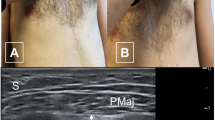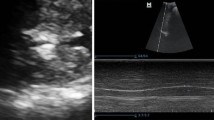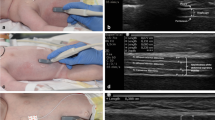Abstract
In classical anatomy textbooks the serratus posterior superior muscle was said to elevate the superior four ribs, thus increasing the AP diameter of the thorax and raising the sternum. However, electromyographic and other studies do not support its role in respiration. In order to help resolve this controversy and provide some insight into their possible functionality, the present study aimed at examining the morphology, topography and morphometry of serratus posterior superior and inferior muscles in both normal specimens and those derived from patients with a history of chronic obstructive pulmonary disorder (COPD). These muscles were examined in 50 human cadavers with an age range of 58–82 years. In 18 of the cadavers their histories revealed that they were suffering from COPD. There was no significant difference between right and left sides, race, gender and age and positive COPD history in regard to dimensions and nerves supply of serratus posterior superior and inferior muscles (P > 0.05). Based upon our findings that no morphometric differences exist between the of serratus posterior superior and inferior muscles of COPD patients versus controls, we are suggesting that no respiratory function be attributed to either of the serratus posterior superior and inferior muscles.




Similar content being viewed by others
References
Bourgery JM (1867–1871) Traité complet de l’anatomie de l’homme, par les Drs Bourgery et Claude Bernard et le professeur-dessinateur-anatomiste N.H. Jacob, avec le concours de Ludovic Hirschfeld. Tome deuxième: Appareil de locomotion, myologie, aponévrologie. L. Guérin, Paris, pp 22–23. http://web2.bium.univ-paris5.fr/livanc/?cote=02083x02&p=28&do=page
Hollinshead WH, Rosse C (eds) (1985) Textbook of anatomy, 4th edn. Harper & Row, Philadelphia, pp 309–310
Loukas M, Louis RG Jr, Hullett J, Loiacano M, Skidd P, Wagner T (2005) An anatomical classification of the variations of the inferior phrenic vein. Surg Radiol Anat 27:566–574
Moore KL, Dalley AF II (eds) (2006) Clinically oriented anatomy, 5th Edn. Lippincott, Williams & Wilkins, Baltimore, p 93
Ogawa T, Jefferson NC, Toman JE, Chiles T, Zambetoglou A, Necheles H (1960) Action potentials of accessory respiratory muscles in dogs. Am J Physiol 199:569–572
Orozco-Levi M (2003) Structure and function of the respiratory muscles in patients with COPD: impairment or adaptation? Eur Respir J Suppl 46:41–51
Polla B, D’Antona G, Bottinelli R, Reggiani C (2004) Respiratory muscle fibres: specialization and plasticity. Thorax 59:808–817
Satoh JI (1969) The serratus posterior superior in certain catarrhine monkeys and man, in particular the structure of the muscular digitations and their nerve supply. Okajimas Folia Anat Jpn 46:65–122
Satoh JI (1970) The serratus posterior inferior in monkey and man, in particular the structure of the digitations of this muscle and their nerve supply. Okajimas Folia Anat Jpn 47:19–61
Scott KW, Hoy J (1976) The cross sectional area of diaphragmatic muscle fibres in emphysema, measured by an automated image analysis system. J Pathol 120:121–128
Sinclair DC (1981) Muscles and fasciae. In: Romanes GJ (ed) Cunningham’s textbook of anatomy, 12th edn. Oxford University Press, Oxford, p 352
Standring S (ed) (2005) Gray’s anatomy, 39th edn. Elsevier, Churchill Livingstone, Edinburgh, pp 961–964
Vilensky JA, Baltes M, Weikel L, Fortin JD, Fourie LJ (2001) Serratus posterior muscles: anatomy, clinical relevance, and function. Clin Anat 14:237–241
Williams PL (ed) (1995) Gray’s anatomy, 38th edn. Churchill Livingstone, New York, p 815
Author information
Authors and Affiliations
Corresponding author
Rights and permissions
About this article
Cite this article
Loukas, M., Louis, R.G., Wartmann, C.T. et al. An anatomic investigation of the serratus posterior superior and serratus posterior inferior muscles. Surg Radiol Anat 30, 119–123 (2008). https://doi.org/10.1007/s00276-008-0305-x
Received:
Accepted:
Published:
Issue Date:
DOI: https://doi.org/10.1007/s00276-008-0305-x




